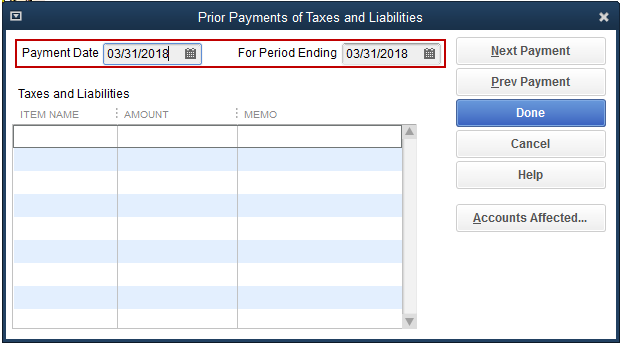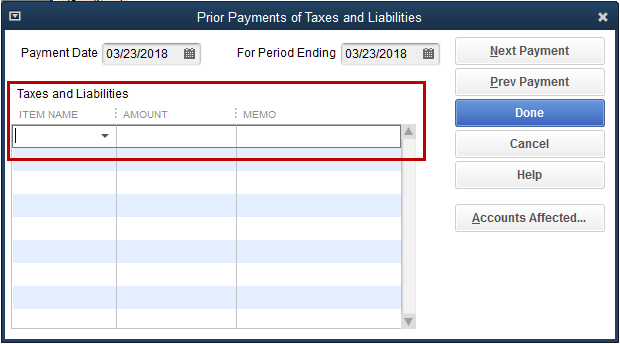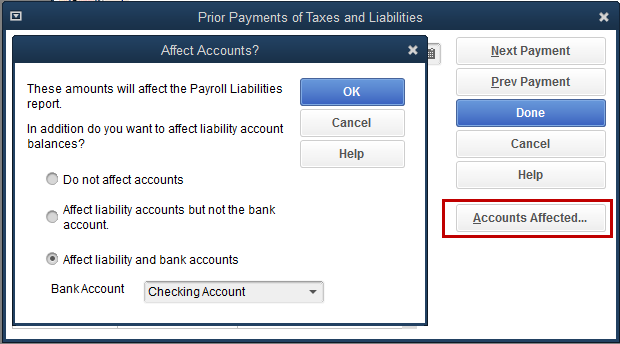Enter historical tax payments in Desktop payroll
by Intuit•3• Updated 9 months ago
Learn how to enter historical tax payments in QuickBooks Desktop Payroll.
In QuickBooks Desktop Payroll, you can enter historical tax payments that you made during the current or previous years before using the payroll service.
QuickBooks Desktop uses this information to determine how much you still owe to federal and state agencies. And to help ensure that your future tax deposits and filings are accurate.
We'll show you the two ways to enter it.
| Note: The process of determining what you still owe requires research into your liabilities and payment amounts. To enter tax payments properly, print and carefully review the Tax Payments Checklist. Or, consult with your accountant. And provide them a copy of the Tax Payments Checklist so that they understand the Payroll Setup requirements of this task. |
Enter historical tax payments using the payroll setup window
If you are trying to enter historical tax payments for the current year, you can use the Payroll Setup window.
- Access the Payroll Setup Interview.
- Proceed to step 5 Year-to-Date Payrolls.
- Select Continue.
- If your company has issued pay checks this year, choose Yes. And select Continue.
- On the next screen, you will have three choices: Paychecks, Tax Payments, and Non-Tax Payments. Select Edit on Tax Payments.
If you need to enter historical pay checks, see Enter historical payroll data in QuickBooks Desktop Payroll. - Print the Tax Payments Checklist. And consult with your accountant before proceeding.
- Select the arrow next to the quarter you would like to enter tax payments in.
- When a quarter is selected, the window will open all taxes owed within that quarter. There will be three columns: QuickBooks - Calculated Amount, Total Amount You've Already Paid, Balance Remaining. Enter the payroll tax payments you've made.
- Once all payments have been entered for a quarter, select the next quarter and repeat the process until all tax payments have been entered.
- If no tax payments have been made, Total Amount You've Already Paid should be empty and columns one and three should match. If they do not match there may be issues when the prior payroll was entered. Which will need to be addressed and corrected before continuing.
- Once the payments are entered, balances in Balance Remaining may need to be paid.
- Select Done Entering in Tax Payments when you have completed entering payments.
Enter historical tax payments outside the Payroll Setup window
If you are trying to enter historical tax payments for the current or previous years, you can use the backdoor process.
- From the Help menu, choose About QuickBooks.
- Press Ctrl + Alt + Y or Ctrl + Shift + Y to open the Setup YTD Amounts window.
- Select Next until you reach the Enter prior payments section.
- In the Enter Prior Payments window, select Create Payment to enter all prior payroll tax and non-tax payroll liability payments you have made during the current or previous years.
- Enter the Payment Date and For Period Ending date accordingly (in many cases these dates will be the same).

(Note: If there is already an item with an amount selected under Taxes and Liabilities, select Next Payment. This may be a prior payment that you have already entered.) - In the Taxes and Liabilities field, choose the payroll tax item that you've already paid and want to record in QuickBooks Desktop. And enter the amount. You can add a memo to remind you what the payment is for.

- Payments for prior quarters are entered as lump sums, and current quarter payments are entered per payroll.
- Select the Accounts Affected... button. This displays options for how you want the payment to affect your Chart of Accounts (COA).

- Do not affect accounts: Use this option if your QuickBooks accounts have correct balances. Selecting this option will cause the prior payment to not show up in the bank register.
- Affect liability accounts but not the bank account: Use this option if your checking account has the correct balance. Selecting this option will cause the prior payment to not show up in the bank register.
- Affect liability and bank accounts: Use this option if none of the account balances are correct. Selecting this option will cause the prior payment to show up in the bank register.
- After you have completed your first payment, continue to the next by selecting Next Payment. Continue this process until you have completed all payments. Then select Done to save your work.
- Select Finish to close the window.
More like this